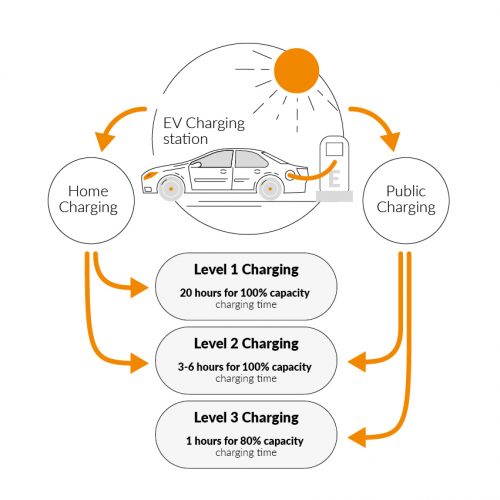Driving to the future: How to select a home EV charging station
In 1990, General Motors introduced their first commercial Electric Vehicles (EVs). Since then, EVs have grown exponentially in popularity thanks to their focus on performance improvement and eco-friendly features and advantages. EVs are expected to become even more popular this decade, steadily replacing traditional combustion engine cars.
Home EV Charging Station

EV charging stations could technically be categorized as Home Charging stations and Public Charging stations depending on the location. Due to the installation location, power and purpose there are 3 levels of charging stations.
- Level 1: The charger comes integrally with the EV from the manufacturer. This level of charger has low charging power and takes about 20h to fully charge the vehicle.
- Level 2: A separated charger from a specialized EV charger manufacturer. At this level, the EV is fully charged within 3 to 6 hours depending on the power capacities of the charger.
- Level 3: Also known as DCFC (Direct Current Fast Charge). This level can rapidly charge the EV to 80% within 1 hour. The remaining 20% is then charged with lower power rates to ensure full charge and safety.
How to select the correct EV charging station
Connector type
There are various charging connectors available on the market today. Depending on whether the vehicle is charged by AC, DC or both, the internal pin terminal has a different arrangement. The most commercially popular is the Type 1 (single phase charging) and Type 2 (single and three-phase charging) connectors for AC charging according to the IEC-62196-2 standard.
Clients need to consult with the EV manufacturer about specifications of their electric vehicle to select the connector most suited to their needs. Manufacturers such as Tesla use their own connector design which is different from the norm.
DCFC charging stations can use combined AC/DC charging connectors to achieve higher charging power levels.
The EV charging solution from SolarEdge provides both the Type 1 and Type 2 connectors. You can simply order the preferred EV charger on our eshop.
Charging speed (amperage and power)
Charging speed depends on two factors. A charger with higher power can fully charge an EV faster but there are limits on both factors.
- The amperage of the charger (usually 16A, 32A and up to 50A).
- The EV’s acceptance rate.
| Charger Amps | Charger Power (at 230V) | Charging Time 0% – 100% 25 kWh | Charging Time 0% – 100% 50 kWh |
| 16 A | 3.68 kW | 6.8 h | 13.6 h |
| 32 A | 7.36 kW | 3.4 h | 6.8 h |
| 50 A | 9.2 kW | 2.7 h | 5.4 h |
SolarEdge EV Charging inverter can provide charging current up to 32A for your EV. This elevated current can fully charge most electric vehicles within 3-4 hours for sustained daily use without needing a full charge. In most cases 1 or 2 hours is already sufficient.
It is important to know in advance where users will plan to charge their EV. Indoor or outdoor installations have different requirements related to safety and security concerns. The location of the charger can also affect the location of the energy source and how much power the user can withdraw from it. Indoor single-phase installation usually limits the amperage to 16A only.
The advantage of using the SolarEdge EV Charging inverter compared to a standard EV charger is when the AC grid limit charging current is at 16A, the inverter can use 16A from the PV solar system to boost the power to your electric vehicle. Therefore, no grid upgrade is required to charge the EV at high power.

Cable length
Appropriate cable length is also very important. The cable length should be from 4 m to 7.5 m to ensure versatility, adaptability and to reduce stress on connection terminals on EV and charger.
SolarEdge EV Charging inverter comes with two cable lengths: 4.5 m and 7.5 m giving the client flexible options for their EV and location.

Warranties
Most charging stations possess a 3-year warranty for all components including the cable and connector. Some manufacturers offer a 5-year warranty for electronic parts and 3-year warranties for the rest.
With SolarEdge EV Charging inverter, clients enjoy a standard warranty of 25 years for the power optimizer, 12 years (extendable to 25 years) for the inverter and 5 years for the cable and connector. Further information about warranties from Solaredge solution can be found on SolarEdge website.
Other aspects
Charging stations come with a holster for holding the connector and cable. This helps the user to efficiently organize the installation. This elegant and modern design is also an added value for both one’s home and EV.
The SolarEdge EV Charging inverter comes with a holster to hold the cable as standard. Furthermore, the black and white color arrangement presents a subtle and aesthetic contrast.
Smart features and their utility
Simple charging stations only allow clients to charge their EV without the option to monitor, control or schedule the charging time. Nowadays, almost everyone has access to smartphones and stable internet connections are available practically everywhere. This allows smarter charging stations to work more efficiently and optimize the charging process so clients can be fully aware of their energy consumption and save energy at the same time.
SolarEdge EV Charging inverter provides full visibility and control via the SolarEdge monitoring platform for every client without any extra cost. Through this app, clients can monitor their consumption, smart-schedule and charging time through multiple sources of energy (grid, or solar) in order to charge the EV.

World’s First 2-in-1 EV Charger and Solar Inverter
SolarEdge’s EV charging single phase inverter enables homeowners to charge their electric vehicles using the power of the sun directly, maximizing solar usage and further lowering electricity bills. They will also benefit from the ability to charge EVs up to 2.5 times faster than a standard EV charger through an innovative solar boost mode that utilizes grid and PV charging simultaneously.
By installing the EV charging inverter, homeowners will benefit from the reduced hassle posed by installing a standalone EV charger separately and a PV inverter, also obtaining optimized integration through the SolarEdge monitoring platform.
Whether your customer owns an electric vehicle now or just wants to be prepared for the EV age, get ready to drive your business into the future with SolarEdge.


Operation modes of SolarEdge EV charging solution
SolarEdge EV Charging Single Phase Inverter: Part 1 – Cable Installation and Activation (EU)
SolarEdge EV Charging Single Phase Inverter: Part 2 – Configuration and Monitoring

Subscribe to our newsletter
so that you don’t miss any news!










